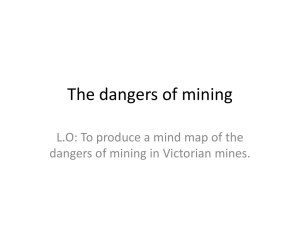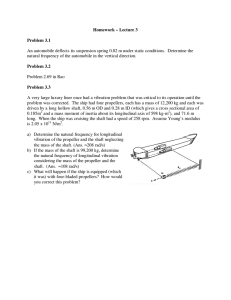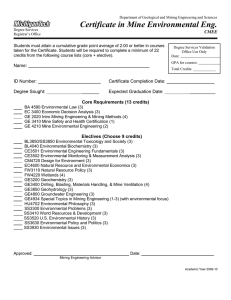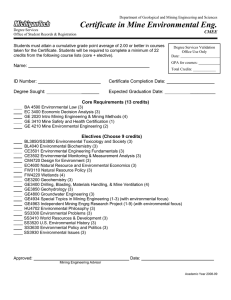New excavations in the Chalcolithic Mine T of Timna Introduction Alexandra Drenka
advertisement
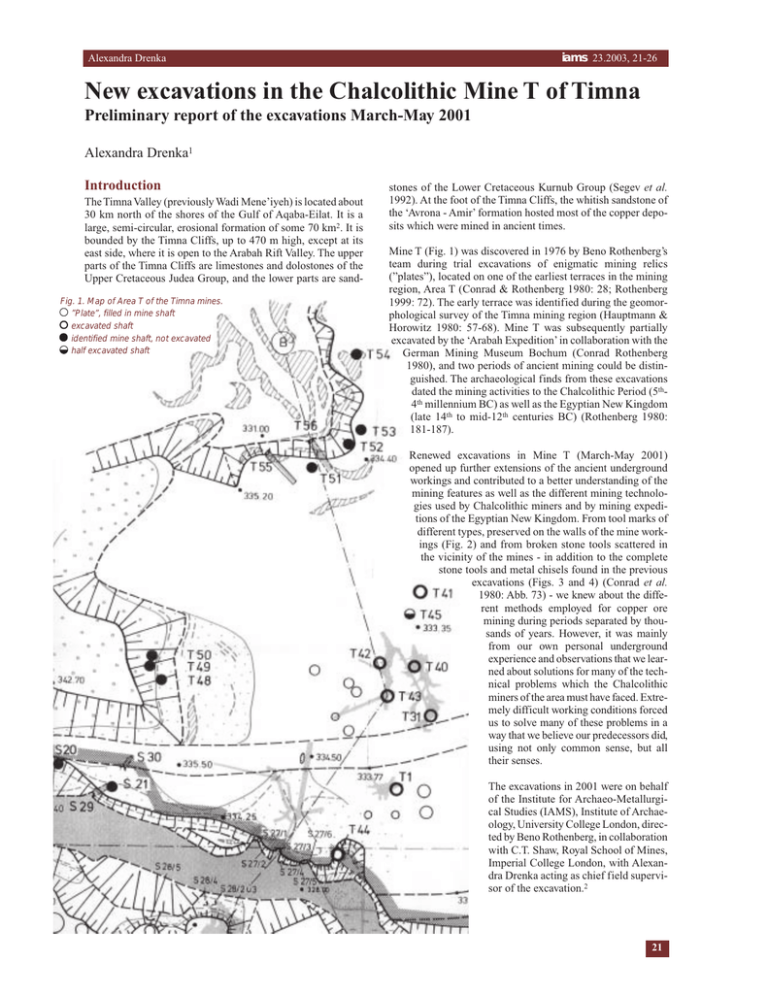
iams 23.2003, 21-26 Alexandra Drenka New excavations in the Chalcolithic Mine T of Timna Preliminary report of the excavations March-May 2001 Alexandra Drenka1 Introduction The Timna Valley (previously Wadi Mene’iyeh) is located about 30 km north of the shores of the Gulf of Aqaba-Eilat. It is a large, semi-circular, erosional formation of some 70 km2. It is bounded by the Timna Cliffs, up to 470 m high, except at its east side, where it is open to the Arabah Rift Valley. The upper parts of the Timna Cliffs are limestones and dolostones of the Upper Cretaceous Judea Group, and the lower parts are sandFig. 1. Map of Area T of the Timna mines. ”Plate”, filled in mine shaft excavated shaft identified mine shaft, not excavated half excavated shaft stones of the Lower Cretaceous Kurnub Group (Segev et al. 1992). At the foot of the Timna Cliffs, the whitish sandstone of the ‘Avrona - Amir’ formation hosted most of the copper deposits which were mined in ancient times. Mine T (Fig. 1) was discovered in 1976 by Beno Rothenberg’s team during trial excavations of enigmatic mining relics (”plates”), located on one of the earliest terraces in the mining region, Area T (Conrad & Rothenberg 1980: 28; Rothenberg 1999: 72). The early terrace was identified during the geomorphological survey of the Timna mining region (Hauptmann & Horowitz 1980: 57-68). Mine T was subsequently partially excavated by the ‘Arabah Expedition’ in collaboration with the German Mining Museum Bochum (Conrad Rothenberg 1980), and two periods of ancient mining could be distinguished. The archaeological finds from these excavations dated the mining activities to the Chalcolithic Period (5th4th millennium BC) as well as the Egyptian New Kingdom (late 14th to mid-12th centuries BC) (Rothenberg 1980: 181-187). Renewed excavations in Mine T (March-May 2001) opened up further extensions of the ancient underground workings and contributed to a better understanding of the mining features as well as the different mining technologies used by Chalcolithic miners and by mining expeditions of the Egyptian New Kingdom. From tool marks of different types, preserved on the walls of the mine workings (Fig. 2) and from broken stone tools scattered in the vicinity of the mines - in addition to the complete stone tools and metal chisels found in the previous excavations (Figs. 3 and 4) (Conrad et al. 1980: Abb. 73) - we knew about the different methods employed for copper ore mining during periods separated by thousands of years. However, it was mainly from our own personal underground experience and observations that we learned about solutions for many of the technical problems which the Chalcolithic miners of the area must have faced. Extremely difficult working conditions forced us to solve many of these problems in a way that we believe our predecessors did, using not only common sense, but all their senses. The excavations in 2001 were on behalf of the Institute for Archaeo-Metallurgical Studies (IAMS), Institute of Archaeology, University College London, directed by Beno Rothenberg, in collaboration with C.T. Shaw, Royal School of Mines, Imperial College London, with Alexandra Drenka acting as chief field supervisor of the excavation.2 21 iams 23.2003, 21-26 Alexandra Drenka The starting point of our excavation was an opening in the north wall of Shaft T40. This was the point where the team of the German Mining Museum Bochum in 1976 stopped their excavations in this area. Continuing north, we cleared another 16.70 m, but we did not reach the end of these workings. However, based on our very detailed investigations, though in a limited section of the mine, we are reasonably confident that we recognized and established the characteristics and features of the Fig. 2. Tools-marks in Mine T: left - Chalcolithic hammer-marks; at the right - New Kingdom chisel-marks. The excavations in Mines T and T13 Six weeks of digging and the removal of tons of sand deposits from underground workings revealed new galleries and chambers, eight new shafts (T1000 - T1007), a large connecting tunnel between Shaft T42 and newly-discovered Shaft T1002, and the most impressive part of Mine T1: the ‘Green Chamber’ (marked in Fig. 5 as Room B). Fig. 3. Chalcolithic mining hammer with typical bi-conic shafthole. Fig. 5. Plan of Mine T and T 1 after excavation in 2001. Fig. 4. Two metal mining tools found in Timna, with proposed reconstruction of complete mining tools. 22 Alexandra Drenka iams 23.2003, 21-26 bably far better-trained in this kind of work, we soon recognised evidence that the ancient miners had the same difficulties just above us. On the ceiling of the tunnel we noticed an irregular circular feature filled with sand and small pebbles, and with no doubt that it was just what we needed - a filled-in ancient shaft - we started to clear it. However, the fill deposit was very compact and very hard to remove. Falling sand and the lack of air and light made such work almost impossible. We therefore decided to try and open the shaft from the surface above. Fig. 6. Supporting pillar. The chisel marks are of the New Kingdom. mining technology used by the earliest underground miners at Timna. It is, therefore, significant to describe in detail the progress of our work, with the emphasis on the working conditions which our team experienced, especially during the first days of digging, since here and then we learned our first lessons of mining. This brought us close to the ancient miners we actually kept following in our excavation. The first few attempts to locate the shaft on the surface were unsuccessful, as it was not sufficient to determine underground the distance from the entrance through the gallery and its orientation. At this point, we found it difficult to understand why the compass and ruler could not solve our problem. Obviously the approximate position of the shaft could not help us much. Finally, the only tools left were our senses. With ears to the ground, we listened while knocking from below, and with our hands slowly moving on the surface, we tried to feel the point of the strongest vibration. We were amazed by the result. Once we had determined the point, we started digging. With confidence and a large pick, we cut through the thin conglomerate cover down to bedrock and soon the outline of a shaft (Shaft T1001) became clearly visible (Fig. 7). A short while afterwards, we could see the darkness of our gallery below. During this season of our excavation, we opened five more shafts using the same method (Shafts T1000 - T1005). It was notable that the ancient miners had often used natural fractures The north gallery (1.70 m wide, measured from the floor, its height 1.72 m) was roughly cut into the soft whitish sandstone formation and was found completely filled with wind-carried yellowish sand mixed with small pebbles. At a distance of about one meter from where we started to excavate, the channel widens slightly on its right side, forming a niche with numerous small cavities. The latter are the result of the miners simply following the copper vein - the copper ore nodules were mostly found in narrow veins of about 5-15 cm - and extracting the ore. At this spot, the ancient miners had decided to leave part of the rock intact and mined all around it, leaving it as a supporting pillar (Fig. 6). On the surface of this pillar are numerous long deep chisel-marks associated with Egyptian New Kingdom mining at Timna (Rothenberg 1980: 182). Such Egyptian presence is attested by their typical toolmarks in many places of the Chalcolithic Mine T. Their intrusive character is usually also recognizable in expended niches or in places very rich in ore; in many of them it is still possible to follow the veins of copper mineralisation. Supporting pillars are also present at other locations in the mine, presumably wherever further work could endanger the safety of the mine. These pillars evidently played a very important role in early mining, providing stability to the underground galleries and safety for the miners. With further progress in removing the fill deposit in the gallery, our working conditions kept deteriorating and our enthusiasm started to slow down. There was very limited space for the person clearing the fill and with each additional bucket conditions were aggravated. When Shaft T40 was 5 meters behind us, these difficulties had intensified by lack of air and light. This was the moment to think about the people who where here a few thousand years ago. How did they overcome these very severe limitations? How did they keep digging and what was the power - or knowledge - which helped them to overcome human basic needs? Though they were less spoiled than we are and pro- Fig. 7. Shaft T1001 - typical for the irregular Chalcolithic ventilation shafts of Mine T. 23 Alexandra Drenka in the rock as the most convenient location to sink a shaft, and moreover that the shaft was cut on one side of the fault whilst the surface of the natural fault formed the other side of the shaft so that the rock there was left almost intact. As a result of leaving untouched one side, and following the face of the sloping fault, this type of shaft is not precisely vertical; this was the reason why we could not locate the shaft on the surface using only our underground measurements and orientation. We very carefully cleaned the shaft walls in order to preserve possible tool-marks, which are of decisive significance for the understanding of the mining technology and for the dating of the mine workings. Indeed, we found numerous round and shallow hammer-marks on the inner walls of Shafts T1004 and T1005, indicating the type of the tools used for sinking these shafts (cf. Fig. 3). However, the bottom of Shaft T1005, as well as its immediate vicinity, is densely covered with long and deep chisel-marks (cf. Fig. 4). Evidently we witness here the overlapping of two different mining technologies: the earlier, using hafted stone hammers, practiced by the Chalcolithic miners of the 5th to 4th millennium BC, and the later, using metal chisel and hammer (‘mallet and gad’) typical for the Egyptian New Kingdom intrusive workings of the 14th-12th centuries BC. Most of the newly discovered shafts, except Shafts T1002 and T1003, are characterised by the same general features: an irregular oval shape with a diameter of 0.65 m to 0.85 m and a depth of 0.80 m to 2.50 m. The distance between the shafts varies from 1.80 m to 5 m. We assume that all these shafts were used for ventilation and light, and some probably also for the transport of copper ore. These ventilation shafts are quite different from the shafts used for the movement of the miners, which often show rough steps, as for instance Shaft T 31 (Fig. 8). Fig. 8. Shaft T32 - typical for shafts used for the movement of miners and ores. 24 iams 23.2003, 21-26 Shafts T1002 and T1003 are somewhat different (Fig. 9). Shaft T1002 was found at a distance of 3.30 m from Shaft T1001. It is a large irregular cavity, roughly hammered out, with dimensions of 3.40 m by 2.40 m (measurements taken from the surface) and depth of 2.00 m to 2.30 m (measured from the surface to the bottom of the mine). This shaft was in fact finally reopened from below, since the surface was very close - only 0.25 m. When Shaft T1002 was partly cleared, we noticed on its southeastern corner a feature which, after complete clearing, turned out to be another attached shaft, T1003. This shaft is very carefully cut, oval in shape, its diameter 0.80 m and its depth 0.85 to 1 m. Chisel-marks are visible all around its walls. After completely clearing these two shafts and exposing their outlines and toolmarks, it was possible to conclude that Shaft T1002 was opened and used by Chalcolithic miners as an opening to their mining ‘galleries’, probably also for ventilation and light, and perhaps also for transport of copper ore. Shaft T1003, of later date, was an Egyptian New Kingdom prospecting shaft, which led into the earlier underground workings, and these the Egyptians simply expanded in search of so far undetected copper ore veins. Further clear evidence of the overlapping of these two completely different mining techniques are the toolmarks in the large niche just below Shaft T1003 and at several places in the gallery between Shafts T40 and T1002, newly cleared by our team. Perhaps the best-preserved wall showing both stonehammer marks and chiselmarks is located in a large niche, approximately 0.80 m north of Shaft T1001. Very intensive mining activities left here numerous small- to medium-sized cavities in the rock. A large portion of the ceiling is covered with roundish, shallow hammermarks, and just below these are deep Fig. 9. Shaft T1002, irregular Chalcolithic shaft, and shaft T1003, regular, oval shaft of the New Kingdom. Alexandra Drenka iams 23.2003, 21-26 Fig. 10. Copper ore nodules in the ceiling of Mine T1 (in the Green Chamber). and long chiselmarks. Evidently this part of the mine workings also saw intensive activities during both the Chalcolithic period and the Egyptian New Kingdom. The most impressive discovery of our excavation is the ‘Green Chamber’ in Mine T1. Here we found large lumps of green copper ore sticking out of the white sandstone, mainly on the ceiling of the ‘Green Chamber’ (Fig. 10). We could only wonder why the ancient miners left behind what they were actually looking for. We must assume that this treasure of copper ore was not exposed in ancient times and was hidden by a layer of sandstone which has eroded with time. If this is the case, we are left with a further question: why has this process not happened in other places of Mine T, or in the other mine workings previously explored by the ‘Arabah Expedition’? The ‘Green Chamber’ (Room B on Fig. 4) is 3.45 m long, 2.50 m wide and, at the highest point, 1.30 m high. It is important to emphasize that this is the largest mined-out space we have seen in Mine T. Its floor slopes northward, and we observed two openings, most probably the entries into further mining galleries. We also observed a possible shaft (T1007), again against a rock fracture, which we decided not to open at this stage. The only access to the ‘Green Chamber’ is from Room A, where we exposed all known features associated with the early mining of Timna: a supporting pillar, numerous irregular cavities of different size, a shaft for ventilation and ore transport (Shaft T1005) (the latter densely covered with the typical early hammermarks), and on the wall just below it, typical chiselmarks of the New Kingdom. More evidence for Egyptian workings was found under Shaft T1005, and on its right side a beautifully carved, very narrow channel, approximately 0.25 m in diameter and at least 2 m long. There are chiselmarks all around its walls, cut along green mineralised copper veins. Further removal of the sand deposit in Room A revealed a transverse tunnel with ceiling and sidewalls covered with chisel-marks. Nowhere in the workings of Mine T did we feel as strong an Egyptian presence as in this room. Although we noticed in the ceiling a small roundish opening next to a crack in the rock, marked on our plan of the mine as Shaft T1006, we were unable to open it. The heavy underground air forced us to discontinue our work here, but we hope to complete our investigation of these workings in the near future. In light of the excavations in Mine T and additional surveys in 2001-2002, it seems evident that underground mining in the Chalcolithic period already existed on a fairly large scale, and that it extended over quite a large area around Mine T. North of the excavated Mine T, the workings go on, as shown by the gallery openings T55 and T56 bearing early hammermarks, with several shafts nearby. There is also further evidence for Chalcolithic mining in Area S (Conrad & Rothenberg 1980: 103150) on both sides of the wadi south of Mine T, again mostly reworked by Egyptian New Kingdom miners. As already established by the excavations in the 1970s (Rothenberg 1980: 170176), Mine T and the other early mine workings in Timna bearing the typical hammermarks, could be dated by archaeo25 iams 23.2003, 21-26 Alexandra Drenka logical evidence, pottery, and flints, to the 5th to 4th millennium BC. These are the earliest copper mines so far discovered in the Levant. Networks of mining galleries and chambers with shafts, the latter being used as mine entrances, for ventilation and light, and for ore transport, represent the very beginnings of underground mining technology, which in later times gradually developed to sophisticated shaft and gallery mining. This is still the principle of mining today. References Conrad, H.G. & Rothenberg, B. (eds) 1980. Antikes Kupfer im Timna-Tal (= Der Anschnitt, Beiheft 1), Bochum. Conrad, H.G., Fober, L., Hauptmann, A., Lieder, W., Ordentlich, I. & Weisgerber, G. 1980. Untersuchungen zur Bergbautechnik und ihre Interpretation. In: H.G. Conrad & B. Rothenberg (eds), Antikes Kupfer im Timna-Tal, 69-94. Hauptmann A. & Horowitz A. 1980. Zur Geomorphologie und Paläomorphologie des Modellgebietes. In: H.G. Conrad & B. Rothenberg (eds), Antikes Kupfer im TimnaTal, 57-68. Rothenberg, B. 1980. Die Chronologie des Bergbaubetriebes. In: H.G. Conrad and B. Rothenberg (eds), Antikes Kupfer im Timna-Tal, 181-186. 26 Rothenberg B. 1999. Archaeo-Metallurgical Researches in the Southern Arabah 19591990. Palestine Exploration Quarterly 131 Part 1: 68-89; Part II: 149-175. Segev, A., Beyth, M., & Bar-Matthews, M. 1992. The Geology of the Timna Valley with emphasis on Copper and Manganese Mineralization - updating and correlation with the Eastern Margins of the Dead Sea (Jerusalem). Notes 1. At the suggestion of Beno Rothenberg, the following preliminary report was written by Alexandra Drenka, in charge of the field work, as a personal report for the director about the excavation of the mine workings, with emphasis on the personal experience of the excavators in the difficult underground workings, clearly reflecting on the problems the ancient miners must have experienced. Once written, it was decided to publish this unique documentation as the supervisor’s preliminary report. A comprehensive report of the excavations in Area T will be published separately (B.R.) 2. We are grateful to Asaf Holzer, the local archaeologist, for his important assistance in running this excavation. 3. In 1976, Mine T1 was excavated as a separate unit (starting with shaft T1), though it was assumed that it was actually a part of adjacent Mine T. For reasons explained in the following, we did not yet succeed to connect these two units.

